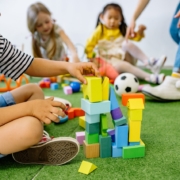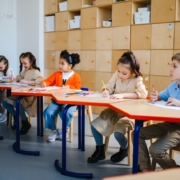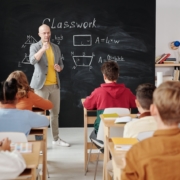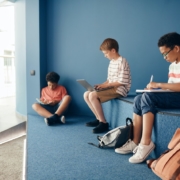Safety and welfare in schools
School safety and welfare refer to the measures taken to ensure a safe, healthy, and secure environment for students, staff, and visitors in educational institutions. This includes physical safety measures, such as emergency preparedness and fire safety, as well as measures aimed at promoting the mental and emotional well-being of students and staff. It also involves policies and procedures for preventing and responding to incidents of bullying, harassment, and discrimination. Additionally, it encompasses providing access to health services, ensuring a safe and healthy learning environment, and providing adequate resources for student support. The ultimate goal of school safety and welfare is to create an environment where students can learn, grow, and succeed.
Table of content
Emergency Preparedness and Response Plans
Emergency Preparedness and Response Plans are crucial components of a comprehensive school safety program. These plans help schools to prepare for, respond to, and recover from emergencies and disasters, such as natural disasters, fires, school shootings, and other incidents that may threaten the safety and well-being of students, staff, and visitors. In this article, we will examine the importance of Emergency Preparedness and Response Plans, the components of such plans, and the steps schools can take to develop and implement effective plans.
The Importance of Emergency Preparedness and Response Plans
Schools face a variety of emergencies and disasters that can disrupt the educational process, threaten the safety and well-being of students, staff, and visitors, and cause significant damage to school property. It is essential for schools to have a well-developed Emergency Preparedness and Response Plan to minimize the impact of such events on the school community.
An effective Emergency Preparedness and Response Plan allows schools to:
- Minimize the impact of emergencies and disasters on students, staff, and visitors.
- Protect school property from damage.
- Ensure the safety and well-being of students, staff, and visitors during and after an emergency.
- Maintain the educational process as much as possible.
- Facilitate an organized and effective response to emergencies and disasters.
- Facilitate the recovery process following an emergency or disaster.
Components of an Emergency Preparedness and Response Plan
An effective Emergency Preparedness and Response Plan should include the following components:
- Hazard Identification and Assessment: The plan should identify potential hazards that the school may face, such as natural disasters, fires, school shootings, and other incidents, and assess the likelihood and impact of such events.
- Emergency Response Procedures: The plan should outline specific procedures to be followed in the event of an emergency, including procedures for evacuating the school, sheltering in place, and communicating with students, staff, and parents.
- Emergency Notification and Communication: The plan should include procedures for quickly and effectively communicating with students, staff, and parents in the event of an emergency. This may include the use of emergency alert systems, text messaging, email, or social media.
- Emergency Response Teams: The plan should identify specific individuals who will be responsible for responding to emergencies and disasters, including school administrators, teachers, and support staff.
- Evacuation Routes and Assembly Areas: The plan should include specific routes for evacuating the school and designated assembly areas for students, staff, and visitors.
- Emergency Supplies and Equipment: The plan should identify and provide for the necessary supplies and equipment to respond to emergencies and disasters, such as first aid kits, fire extinguishers, and personal protective equipment.
- Training and Drills: The plan should include provisions for regularly conducting emergency drills and training for students, staff, and visitors to ensure that everyone is prepared and knows what to do in the event of an emergency.
Steps for Developing and Implementing an Emergency Preparedness and Response Plan
- Assess the school’s hazards: Identify the types of emergencies and disasters that the school may face and assess the likelihood and impact of each event.
- Develop the plan: Based on the results of the hazard assessment, develop a comprehensive Emergency Preparedness and Response Plan that includes all of the components discussed above.
- Involve all stakeholders: Involve students, staff, parents, and other members of the community in the development and implementation of the plan. This will help to ensure that the plan is comprehensive
Bullying Prevention in schools
Bullying is a serious issue that affects many students in schools and can have a negative impact on their social and emotional well-being. It is important for schools to implement effective bullying prevention programs to create a safe and supportive learning environment for all students. In this article, we will examine the nature and effects of bullying, the importance of bullying prevention in schools, and strategies that schools can use to prevent bullying.
Nature and Effects of Bullying
Bullying is defined as intentional and repeated harm that is inflicted by one or more individuals upon another individual or group. It can take many forms, including physical violence, verbal aggression, cyberbullying, and social exclusion. Bullying can have a profound impact on the well-being of students, leading to physical injury, emotional distress, and decreased academic performance. It can also contribute to a toxic school culture that affects the entire school community.
The Importance of Bullying Prevention in Schools
Bullying prevention is an important aspect of school safety and well-being, as it promotes a safe and supportive learning environment for all students. Effective bullying prevention programs can help to reduce the prevalence of bullying in schools, improve school culture, and support the well-being of students who have experienced bullying.
Bullying prevention programs can also benefit schools by:
- Improving academic performance: When students feel safe and supported, they are more likely to engage in learning and perform better academically.
- Promoting positive school culture: A positive school culture is essential for student well-being and academic success. Effective bullying prevention programs can help to promote a positive school culture by reducing the prevalence of bullying and promoting respect and inclusion.
- Reducing absenteeism: Students who experience bullying are more likely to miss school, which can negatively impact their academic performance. Effective bullying prevention programs can help to reduce absenteeism by promoting a safe and supportive learning environment.
Strategies for Preventing Bullying in Schools
There are several strategies that schools can use to prevent bullying and create a safe and supportive learning environment for all students. These include:
- Establishing clear policies and procedures: Schools should have clear policies and procedures in place for addressing bullying, including procedures for reporting bullying incidents, investigating reports of bullying, and providing support to students who have experienced bullying.
- Implementing school-wide programs: School-wide programs, such as social and emotional learning programs, can help to promote a positive school culture and prevent bullying.
- Providing training and education: Providing training and education to students, staff, and parents can help to raise awareness about bullying, promote a positive school culture, and provide strategies for preventing bullying.
- Encouraging students to speak out: Encouraging students to speak out about bullying and providing them with resources for reporting incidents can help to reduce the prevalence of bullying and promote a safe and supportive learning environment.
- Responding promptly and effectively: When incidents of bullying are reported, schools should respond promptly and effectively, including conducting investigations, providing support to students who have experienced bullying, and holding perpetrators accountable for their actions.
Conclusion
Bullying is a serious issue that affects many students in schools and can have a negative impact on their well-being. It is important for schools to implement effective bullying prevention programs to create a safe and supportive learning environment for all students. Effective bullying prevention programs can benefit schools by improving academic performance, promoting a positive school culture, and reducing absenteeism. Schools can use a variety of strategies to prevent bullying, including establishing clear policies and procedures, implementing school-wide programs, providing training and education, encouraging students to speak out, and responding promptly and effectively to incidents of bullying
Mental Health Support in schools
Mental health is a critical component of overall health and well-being, and it is important for schools to provide support to students to promote positive mental health. Mental health support in schools can take many forms, including counseling services, mental health education, and referrals to community resources. In this article, we will examine the importance of mental health support in schools, the challenges that schools face in providing mental health support, and strategies that schools can use to support the mental health of students.
The Importance of Mental Health Support in Schools
Mental health support is critical for the well-being of students and their academic success. Mental health issues can impact a student’s ability to learn, to form and maintain healthy relationships, and to engage in daily activities. Moreover, mental health issues can also impact the overall school climate, leading to a toxic environment that affects the entire school community.
The challenges that schools face in providing mental health support include:
- Limited resources: Many schools struggle with limited resources and budget constraints, making it difficult to provide mental health support to students.
- Stigma: There is often a stigma associated with mental health issues, which can make it difficult for students to seek help.
- Lack of training: Teachers and other school staff may not have the training and skills needed to provide mental health support to students.
Strategies for Supporting the Mental Health of Students in Schools
Despite the challenges, there are several strategies that schools can use to support the mental health of students, including:
- Providing counseling services: Schools can provide counseling services to students, either through school-based counseling programs or by referring students to community resources.
- Providing mental health education: Schools can provide mental health education to students, staff, and parents, including information about the signs and symptoms of mental health issues, and strategies for promoting positive mental health.
- Creating a supportive school climate: Schools can create a supportive school climate by promoting respect, inclusion, and positive relationships, and by addressing bullying and other forms of aggression.
- Encouraging self-care: Schools can encourage students to practice self-care, such as engaging in physical activity, eating a healthy diet, and getting adequate sleep, as a way to promote positive mental health.
- Encouraging open and honest communication: Schools can encourage open and honest communication about mental health, reducing the stigma associated with mental health issues and making it easier for students to seek help when needed.
- Providing resources for families: Schools can provide resources for families, such as information about community mental health resources, to support the mental health of students.
Conclusion
Mental health is a critical component of overall health and well-being, and it is important for schools to provide support to students to promote positive mental health. The challenges that schools face in providing mental health support include limited resources, stigma, and lack of training. However, there are several strategies that schools can use to support the mental health of students, including providing counseling services, mental health education, creating a supportive school climate, encouraging self-care, encouraging open and honest communication, and providing resources for families. By implementing these strategies, schools can help to promote the mental health of students and create a safe and supportive learning environment for all.
Physical Safety in schools
Physical safety in schools is a critical concern for parents, educators, and students. Schools are places where students spend a large portion of their day and should be safe, secure environments for learning and growth. However, there are many threats to physical safety in schools, including violence, bullying, accidents, and natural disasters. In this article, we will examine the importance of physical safety in schools, the challenges that schools face in ensuring physical safety, and strategies that schools can use to promote physical safety in schools.
The Importance of Physical Safety in Schools
Physical safety in schools is critical for several reasons. First and foremost, schools should be safe and secure environments where students feel protected and can focus on learning. In addition, physical safety in schools is important for the well-being of students, teachers, and staff, and for the overall school climate. Threats to physical safety in schools can lead to absenteeism, decreased academic performance, and emotional distress for students, and can also impact the morale and well-being of teachers and staff.
The Challenges of Ensuring Physical Safety in Schools
Ensuring physical safety in schools is a complex challenge, and schools face many obstacles, including:
- Budget constraints: Schools often face budget constraints that limit their ability to invest in physical safety measures, such as security cameras, access control systems, and disaster preparedness equipment.
- Lack of training: Teachers and staff may not have the training and skills needed to respond effectively to emergencies and to promote physical safety in schools.
- Student misbehavior: Students may engage in misbehavior that puts themselves and others at risk, such as bullying, substance abuse, and violence.
Strategies for Promoting Physical Safety in Schools
Despite the challenges, there are several strategies that schools can use to promote physical safety in schools, including:
- Developing a comprehensive emergency response plan: Schools should develop a comprehensive emergency response plan that includes procedures for responding to emergencies, such as natural disasters, accidents, and acts of violence. This plan should be reviewed and updated regularly.
- Providing training and resources: Schools should provide training and resources to teachers, staff, and students on emergency response procedures and physical safety, including disaster preparedness and response, first aid and CPR, and emergency evacuation.
- Implementing security measures: Schools should implement physical security measures to reduce the risk of violence, such as access control systems, security cameras, and metal detectors.
- Addressing student misbehavior: Schools should address student misbehavior, such as bullying and substance abuse, through a combination of education, counseling, and discipline.
- Partnering with community organizations: Schools should partner with community organizations, such as local law enforcement agencies and emergency management organizations, to enhance physical safety in schools.
- Encouraging reporting: Schools should encourage students, teachers, and staff to report any concerns about physical safety, and should have systems in place for responding to these reports in a timely and effective manner.
Conclusion
Physical safety in schools is a critical concern for parents, educators, and students. Threats to physical safety in schools can impact the well-being of students, teachers, and staff, and can also affect the overall school climate. Schools face many challenges in ensuring physical safety, including budget constraints, lack of training, and student misbehavior. However, by developing a comprehensive emergency response plan, providing training and resources, implementing security measures, addressing student misbehavior, partnering with community organizations, and encouraging reporting, schools can promote physical safety in schools and create a safe and secure learning environment for all.
Substance Abuse Prevention in schools
Substance abuse is a serious problem in society, and schools play a crucial role in preventing substance abuse among students. Substance abuse can lead to a range of negative outcomes, including poor academic performance, health problems, and an increased risk of addiction and overdose. In this article, we will examine the impact of substance abuse on schools, the challenges that schools face in preventing substance abuse, and strategies that schools can use to promote substance abuse prevention.
The Impact of Substance Abuse on Schools
Substance abuse has a significant impact on schools, affecting students, teachers, and staff, as well as the overall school climate. Substance abuse can lead to:
- Decreased academic performance: Substance abuse can negatively impact students’ academic performance, causing them to miss school, have lower grades, and be more likely to drop out.
- Health problems: Substance abuse can cause a range of health problems, including addiction, overdose, and long-term health complications.
- Increased risk of violence and crime: Substance abuse can increase the risk of violence and crime in schools, putting students, teachers, and staff at risk.
- Reduced school morale: Substance abuse can reduce school morale, affecting the overall school climate and making it more difficult for students to learn and thrive.
The Challenges of Substance Abuse Prevention in Schools
Preventing substance abuse in schools is a complex challenge, and schools face many obstacles, including:
- Peer pressure: Students may be influenced by peer pressure to use drugs or alcohol, making it difficult for schools to prevent substance abuse.
- Lack of resources: Schools may lack the resources, such as funding, personnel, and training, to implement effective substance abuse prevention programs.
- Limited understanding of substance abuse: Schools may have limited understanding of substance abuse, including its causes, consequences, and effective prevention strategies.
Strategies for Substance Abuse Prevention in Schools
Despite the challenges, there are several strategies that schools can use to prevent substance abuse, including:
- Implementing evidence-based programs: Schools should implement evidence-based substance abuse prevention programs, such as those that promote healthy decision-making and provide education on the dangers of substance abuse.
- Building relationships with students: Schools should build relationships with students and provide support, resources, and counseling to those who may be at risk of substance abuse.
- Engaging parents and community members: Schools should engage parents and community members in substance abuse prevention efforts, and provide them with resources and education on the issue.
- Addressing substance abuse through a comprehensive approach: Schools should address substance abuse through a comprehensive approach that includes education, counseling, and discipline, as well as support for students who are struggling with substance abuse.
- Promoting a positive school climate: Schools should promote a positive school climate that supports student well-being, positive behavior, and healthy decision-making.
Conclusion
Substance abuse is a serious problem in society, and schools play a crucial role in preventing substance abuse among students. Substance abuse can lead to a range of negative outcomes, including poor academic performance, health problems, and an increased risk of violence and crime. Schools face many challenges in preventing substance abuse, including peer pressure, lack of resources, and limited understanding of the issue. However, by implementing evidence-based programs, building relationships with students, engaging parents and community members, addressing substance abuse through a comprehensive approach, and promoting a positive school climate, schools can prevent substance abuse and create safe and healthy learning environments for all.
Cyber Safety in schools
Cyber safety is a growing concern in today’s world, where technology plays an increasingly important role in our lives. Schools are no exception, and it is important that they take steps to ensure that students are safe online. Cyber safety refers to the measures that are taken to protect individuals and organizations from online threats, such as hacking, cyberbullying, and identity theft. In this article, we will examine the challenges that schools face in ensuring cyber safety, the impact of cyber safety on schools, and strategies that schools can use to promote cyber safety among students.
The Challenges of Cyber Safety in Schools
Ensuring cyber safety in schools is a complex challenge, and schools face many obstacles, including:
- Keeping up with technology: Technology is constantly evolving, and schools must work to keep up with the latest online threats and the tools that are used to prevent them.
- Lack of resources: Schools may lack the resources, such as funding, personnel, and training, to effectively implement cyber safety measures.
- Limited understanding of cyber safety: Schools may have limited understanding of cyber safety, including the dangers of the online world, how to recognize online threats, and how to prevent them.
- Balancing cyber safety with the benefits of technology: Schools must balance the need for cyber safety with the many benefits that technology can bring to the classroom, such as increased access to information and new learning opportunities.
The Impact of Cyber Safety on Schools
Cyber safety is an important issue for schools, as it affects students, teachers, and staff, as well as the overall school climate. Cyber safety can lead to:
- Cyberbullying: Cyberbullying is a growing problem, and it can have a serious impact on the mental health and well-being of students.
- Identity theft: Cyber criminals can use personal information to steal identities and commit other types of fraud.
- Loss of privacy: Online threats can compromise the privacy of individuals and organizations, putting sensitive information at risk.
- Decreased productivity: Cyber threats can disrupt the operations of schools, causing downtime and decreased productivity.
Strategies for Promoting Cyber Safety in Schools
Despite the challenges, there are several strategies that schools can use to promote cyber safety among students, including:
- Implementing technology policies: Schools should have clear and concise policies that outline the expectations for technology use, including rules for cyber safety.
- Providing cyber safety education: Schools should educate students on the dangers of the online world, how to recognize online threats, and how to prevent them.
- Encouraging responsible technology use: Schools should encourage students to use technology responsibly, and to report any online threats or inappropriate behavior.
- Engaging parents and community members: Schools should engage parents and community members in cyber safety efforts, and provide them with resources and education on the issue.
- Monitoring technology use: Schools should monitor technology use, and take appropriate steps to address any online threats or inappropriate behavior.
Conclusion
Cyber safety is a growing concern in today’s world, and schools play an important role in ensuring that students are safe online. Ensuring cyber safety in schools is a complex challenge, and schools face many obstacles, including the need to keep up with technology, limited resources, and limited understanding of the issue. However, by implementing technology policies, providing cyber safety education, encouraging responsible technology use, engaging parents and community members, and monitoring technology use, schools can promote cyber safety among students and create a safe and secure online environment for all.
Sexual Harassment Prevention in schools:
Sexual harassment is a serious problem that affects students, teachers, and staff in schools. It is important for schools to take steps to prevent sexual harassment, and to ensure that students are protected from this form of abuse. In this article, we will examine the challenges that schools face in preventing sexual harassment, the impact of sexual harassment on schools, and strategies that schools can use to promote a safe and respectful school environment.
The Challenges of Preventing Sexual Harassment in Schools
Preventing sexual harassment in schools is a complex challenge, and schools face many obstacles, including:
- Limited understanding of sexual harassment: Schools may have limited understanding of sexual harassment, including the definition of sexual harassment, the forms it can take, and the consequences it can have.
- Lack of resources: Schools may lack the resources, such as funding, personnel, and training, to effectively prevent and address sexual harassment.
- Balancing the rights of all parties: Schools must balance the rights of all parties involved in a sexual harassment complaint, including the complainant, the accused, and any witnesses.
- Addressing cultural and societal attitudes: Schools must work to address cultural and societal attitudes that may contribute to sexual harassment, and to promote a safe and respectful school environment.
The Impact of Sexual Harassment on Schools
Sexual harassment can have a serious impact on the students, teachers, and staff who are affected by it, as well as on the overall school climate. Sexual harassment can lead to:
- Decreased academic performance: Sexual harassment can cause stress and anxiety, which can negatively impact academic performance.
- Mental health problems: Sexual harassment can cause serious mental health problems, including depression, anxiety, and post-traumatic stress disorder.
- Loss of confidence: Sexual harassment can cause students to lose confidence in themselves, their abilities, and their future.
- Decreased motivation and engagement: Sexual harassment can decrease motivation and engagement among students, teachers, and staff.
Strategies for Preventing Sexual Harassment in Schools
Despite the challenges, there are several strategies that schools can use to prevent sexual harassment, including:
- Implementing clear and concise policies: Schools should have clear and concise policies that outline the expectations for behavior, and that clearly define sexual harassment and the consequences for violating these policies.
- Providing training and education: Schools should provide training and education to students, teachers, and staff on the issue of sexual harassment, and on how to prevent and respond to it.
- Encouraging reporting: Schools should encourage students, teachers, and staff to report any incidents of sexual harassment, and to provide them with the resources and support they need to do so.
- Responding quickly and effectively: Schools should respond quickly and effectively to any reports of sexual harassment, and should take appropriate steps to address the issue and support those affected.
- Engaging parents and community members: Schools should engage parents and community members in efforts to prevent sexual harassment, and to provide them with resources and education on the issue.
Conclusion
Sexual harassment is a serious problem that affects students, teachers, and staff in schools. It is important for schools to take steps to prevent sexual harassment, and to ensure that students are protected from this form of abuse. Despite the challenges, schools can promote a safe and respectful school environment by implementing clear and concise policies, providing training and education, encouraging reporting, responding quickly and effectively, and engaging parents and community members. By taking these steps, schools can help to create a safe and supportive learning environment for all students, and help to prevent the devastating impact of sexual harassment on individuals and communities.









